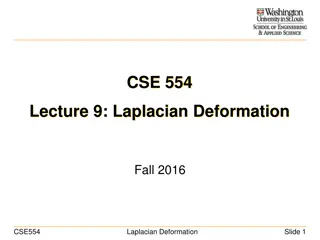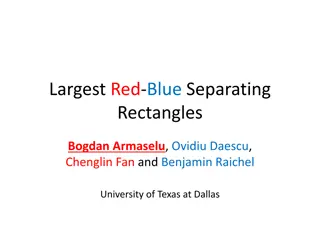
Key Points of Navigational and Ancillary Information Facility in April 2023
Explore the essential aspects of the Navigational and Ancillary Information Facility (N.IF) in April 2023. Understand the SPICE toolkit, primary kernel interfaces, and key subsystems for effective navigation and computation. Learn about the common SPICE APIs and their usage with different kernel types.
Download Presentation

Please find below an Image/Link to download the presentation.
The content on the website is provided AS IS for your information and personal use only. It may not be sold, licensed, or shared on other websites without obtaining consent from the author. If you encounter any issues during the download, it is possible that the publisher has removed the file from their server.
You are allowed to download the files provided on this website for personal or commercial use, subject to the condition that they are used lawfully. All files are the property of their respective owners.
The content on the website is provided AS IS for your information and personal use only. It may not be sold, licensed, or shared on other websites without obtaining consent from the author.
E N D
Presentation Transcript
N IF Navigation and Ancillary Information Facility Summary of Key Points April 2023
N IF Which Pieces of SPICE Must I Use? Navigation and Ancillary Information Facility There s not a simple answer Depends on what activity or mission you are working on Depends on what computation(s) you wish to make Don t feel overwhelmed Many seemingly complex computations can be made using just a few SPICE APIs The next several charts highlight some key points We assume you have already looked at the major SPICE tutorials, or already have some familiarity with SPICE We assume you have successfully downloaded and installed the SPICE Toolkit Consider printing this tutorial and keeping it near your workstation Summary of Key Points 2
N IF Reminder of Key Subsystems Navigation and Ancillary Information Facility SPK: PCK: Position (and velocity) of things ( ephemeris objects ) Size/shape/orientation of solar system bodies For binary PCKs, only orientation is provided; use a text PCK to obtain size/shape See also DSK below Instrument field-of-view geometry (see also FK below) Orientation of spacecraft or spacecraft structures that rotate Definition and specification details for many reference frames; also includes instrument mounting alignments DSK: High fidelity shape data, better than what s in a text PCK (But limited availability) LSK: Time conversion: UTC (SCET) ET (TDB) SCLK and LSK: Time conversion: SCLK ET (TDB) IK: CK: FK: Summary of Key Points 3
N IF Primary Kernel Interfaces - 1 Navigation and Ancillary Information Facility Which SPICE APIs are most commonly used with a given kernel type? SPKEZR, SPKPOS, SPKCOV, SPKOBJ SXFORM, PXFORM, SPKEZR, SPKPOS SPK FK SXFORM, PXFORM, SPKEZR, SPKPOS, BODVRD STR2ET, TIMOUT, SCE2C, SCT2E, SCE2S, SCS2E LSK PCK SCS2E, SCE2S SXFORM, PXFORM, SPKEZR, SPKPOS GETFVN, GETFOV, G*POOL IK SCLK SXFORM, PXFORM SPKEZR, SPKPOS, CKCOV, CKOBJ (CKGPAV, CKGP) SINCPT, LATSRF, ILLUMF, SRFNRM, LIMBPT, TERMPT, ... CK DSK* * Partial implementation starting with N66 Toolkits Notes: FURNSH is used to load (provide access to ) all SPICE kernels. API names shown are for FORTRAN versions: - use lower case and add an _c when using C - use lower case and prepend cspice_ when using Icy (IDL) and Mice (MATLAB) Summary of Key Points 4
N IF Primary Kernel Interfaces - 2 Navigation and Ancillary Information Facility For a given high-level Toolkit API, which kinds of kernels will or may be needed? Kernel Type(s) Needed API Name SPK PCK IK CK FK LSK SCLK DSK Y M M M M M M M Y M L M L M L M M L SPKEZR, SPKPOS SXFORM, PXFORM CKGP, CKGPAV Y M GETFVN, GETFOV M G*POOL STR2ET, TIMOUT Y Y Y Y M SCS2E, SCE2S M M M M CHRONOS (time conversion app.) Yes = is needed Likely = very likely needed Maybe = may be needed Summary of Key Points 5
N IF Primary Kernel Interfaces - 3 Navigation and Ancillary Information Facility More: for a given high-level API, which kinds of kernels will or may be needed? Kernel Type(s) Needed API Name SPK PCK IK CK FK LSK SCLK DSK* Y Y M L Y M M L L L M L Y M M M M M M M M M M M M M L L M M M M M M M M L L M M L L L M L L M M M M M M M M M M M SINCPT TANGPT Y M M M M M M M DSKXV, DSKXSI LATSRF Y Y Y ILUMIN, ILLUMG, ILLUMF SUBPNT, SUBSLR GFOCLT, OCCULT SRFNRM Y Y LIMBPT TERMPT Yes = is needed Likely = likely needed Maybe = may be needed * Partial implementation starting with N67 Toolkits Summary of Key Points 6
N IF Kernel Coverage Cautions Navigation and Ancillary Information Facility Your set of kernels must: contain data for all objects of interest Sometimes you must include intermediary objects that provide a connection (recall the chaining discussion in the SPK tutorial) contain data covering the time span(s) of interest to you Watch out for data gaps within that time span Watch out for the difference between ET and UTC The difference as of 2017 January 01 is ~69.182 seconds (ET > UTC) contain all the kernel types needed by SPICE to answer your question As the previous charts show, you may need one or more kernels that are not obvious be managed (loaded) properly if there are overlapping (competing) data within the set of files you are using Summary of Key Points 7
N IF What Kernels are Available? Navigation and Ancillary Information Facility It depends on the mission or task you are working on. There are typically three categories of kernel data available. Mission operations kernels those used by the flight teams to fly the mission and prepare the archival science products These are the most up to date, but it could be a challenge to select the ones you need PDS Archived kernels those that have been selected from (or made from) the mission ops kernels, and then are well organized and documented for the PDS archive. These data sets are well organized, well documented, and contain helpful furnsh kernels (meta-kernels). Generic kernels those that are used by many missions and are not tied to any one mission Relevant generic kernels are usually included in the PDS Archived and the Mission Operations kernels data sets mentioned above All three types can be found here: https://naif.jpl.nasa.gov/naif/data.html The situation might be similar for non-JPL missions, but this is up to whatever institution is producing the kernels. Summary of Key Points 8
How Can I Find Possibly Useful Toolkit APIs? N IF Navigation and Ancillary Information Facility Review the previous charts Look at the appropriate SPICE tutorial(s) Look at the Most Used xxx APIs document /doc/html/info/mostused.html Search the permuted index: spicelib_idx for the FORTRAN toolkits /doc/html/info/spicelib_idx.html This index also correlates entry point names with source code files. cspice_idx for the C toolkits /doc/html/info/cspice_idx.html icy_idx for the IDL toolkits /doc/html/info/icy_idx.html mice_idx for the MATLAB toolkits /doc/html/info/mice_idx.html Read relevant portions of a SPICE required reading technical reference document (e.g. spk.req ) /doc/html/req/spk.html for the hyperlinked html version (best) /doc/spk.req for the plain text version Summary of Key Points 9
How Can I Understand How To Use Those APIs? N IF Navigation and Ancillary Information Facility The primary user-oriented documentation about each API is found in the header located at the top of each source code file and also in the API's HTML page in the API reference guide. You can Google an API name to see its header For example: spkezr, spkezr_c, or cspice_spkezr (for Icy or Mice) (More documentation is found at the additional entry points for those FORTRAN APIs that have multiple entry points.) Reference documentation for major subsystems is found in like-named required reading documents (e.g. spk.req, ck.req, etc.) The SPICE tutorials contain much helpful information. NAIF s self-training materials provide an orderly approach to learning about SPICE: https://naif.jpl.nasa.gov/naif/self_training.html Summary of Key Points 10
N IF Does NAIF Provide Any Examples? Navigation and Ancillary Information Facility Nearly all API headers contain one or more working examples Most Used SPICELIB Subroutines has code fragments /doc/html/info/mostused.html The required reading reference documents often contain examples /doc/html/req/index.html The Program_<language> tutorial contains a substantial working example Some simple cookbook programs are found in the Toolkit /src/cookbook/ Make use of the SPICE Programming Lessons available from the NAIF server https://naif.jpl.nasa.gov/pub/naif/toolkit_docs/Lessons/ Summary of Key Points 11






















